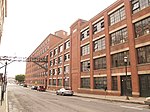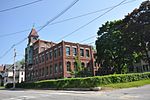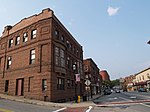Gardner station
1851 establishments in Massachusetts1986 disestablishments in MassachusettsBuildings and structures in Gardner, MassachusettsFormer Boston and Maine Railroad stationsFormer MBTA stations in Massachusetts ... and 6 more
MBTA Commuter Rail stations in Worcester County, MassachusettsRailway stations in the United States closed in 1960Railway stations in the United States closed in 1986Railway stations in the United States opened in 1851Railway stations in the United States opened in 1980Union stations in the United States

Gardner station is a former station stop on the MBTA Commuter Rail Fitchburg Line, located in Gardner, Massachusetts. Passenger service to Union Station ran from 1851 until 1960, and commuter service also briefly ran from 1980 to 1986. Restoration of passenger service was considered in the early 2000s, but was rejected due to low cost-effectiveness.
Excerpt from the Wikipedia article Gardner station (License: CC BY-SA 3.0, Authors, Images).Gardner station
Main Street, Gardner
Geographical coordinates (GPS) Address Nearby Places Show on map
Geographical coordinates (GPS)
| Latitude | Longitude |
|---|---|
| N 42.5675 ° | E -71.9848 ° |
Address
Main Street 555
01440 Gardner
Massachusetts, United States
Open on Google Maps











